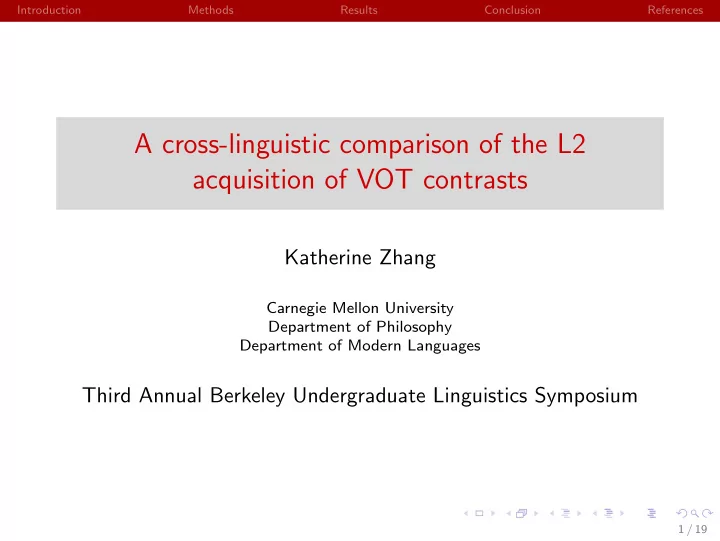

Introduction Methods Results Conclusion References A cross-linguistic comparison of the L2 acquisition of VOT contrasts Katherine Zhang Carnegie Mellon University Department of Philosophy Department of Modern Languages Third Annual Berkeley Undergraduate Linguistics Symposium 1 / 19
Introduction Methods Results Conclusion References Acquiring foreign phonetics is hard! Two types of “new” categories to learn: 1 Entirely new category • No counterpart in L1 • e.g., French /y/ for English speakers 2 Shifted category • Easily identifiable counterpart in L1 • But systematic phonetic differences • e.g., French stop consonants, different VOT 2 / 19
Introduction Methods Results Conclusion References Past Studies • New categories are easier to approximate than shifted categories (Flege 1987) • Approximation of VOT varies with L2 experience in adult learners (Flege 1987) • Heritage speakers and early learners fully differentiate VOT values in L1 and L2 (Flege 1991; Chang et al. 2011) 3 / 19
Introduction Methods Results Conclusion References What is VOT? Voice-onset time (VOT) is the time between the release of a stop consonant and the onset of voicing. 4 / 19
Introduction Methods Results Conclusion References Comparison of VOT in word-initial stops French (Flege 1987) : Mandarin (Chang et al. 2011) : • Voiced vs. voiceless • Unaspirated vs. aspirated • /b d g/ negative VOT • /b d g/ short positive VOT • /p t k/ short positive VOT • /p t k/ long positive VOT English (Flege 1987; Chang et al. 2011) : • /b d g/ short positive VOT • /p t k/ VOT in between French and Mandarin 5 / 19
Introduction Methods Results Conclusion References Present Study Which stop contrast is easier for native English speakers to acquire? • Adult learners of French or Mandarin • 15 participants initially • 9 participants now • All my French learners dropped out :( • Three recording sessions over course of semester 6 / 19
Introduction Methods Results Conclusion References Present Study Stimuli: Tasks for participants: • Words taken from French and Chinese textbooks 1 Shadowing • No high front or front rounded vowels 2 Reading after target consonants • Mandarin romanized in Pinyin • Monolingual native speakers recorded for shadowing stimuli 7 / 19
Introduction Methods Results Conclusion References Hypotheses 1 Acquire French contrast faster • Entire contrast shifted • More like learning new categories? 2 Acquire Mandarin contrast faster • Only /p t k/ category shifted • More similar to English? • Acquire contrast in shadowing faster than in reading 8 / 19
Introduction Methods Results Conclusion References Recording Details • Sound-proof booth • 44100 Hz sampling frequency • VOT measured in Praat 9 / 19
Introduction Methods Results Conclusion References Today’s presentation Focus on results from Mandarin sessions 1 and 2, comparing reading and shadowing 10 / 19
Introduction Methods Results Conclusion References Average VOT of native speakers 11 / 19
Introduction Methods Results Conclusion References Average VOT, all participants 12 / 19
Introduction Methods Results Conclusion References Average VOT, individual participant 13 / 19
Introduction Methods Results Conclusion References Average VOT, individual participant 14 / 19
Introduction Methods Results Conclusion References Average VOT, individual participant 15 / 19
Introduction Methods Results Conclusion References Discussion • Difference between shadowing and reading for most participants • Difficulty with tones? • Maybe less difference with French • No difference between session 1 and 2 in most cases 16 / 19
Introduction Methods Results Conclusion References Future • This semester: Mandarin data for session 3 • Next semester: French, Spanish (negative VOT languages) 17 / 19
Introduction Methods Results Conclusion References Thank you! 18 / 19
Introduction Methods Results Conclusion References References Chang, Charles B et al. (2011). “Production of phonetic and phonological contrast by heritage speakers of Mandarin”. In: The Journal of the Acoustical Society of America 129.6. Flege, James Emil (1987). “The production of “new” and “similar” phones in a foreign language: Evidence for the effect of equivalence classification”. In: Journal of phonetics 15.1. – (1991). “Age of learning affects the authenticity of voice-onset time (VOT) in stop consonants produced in a second language”. In: The Journal of the Acoustical Society of America 89.1. 19 / 19
Recommend
More recommend